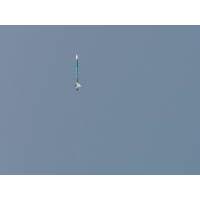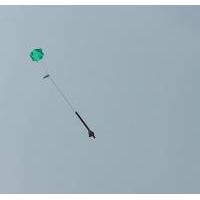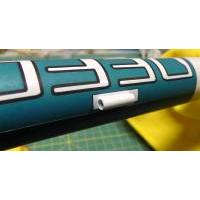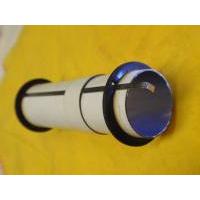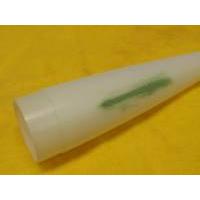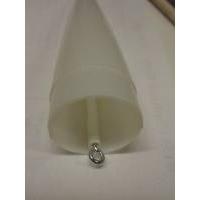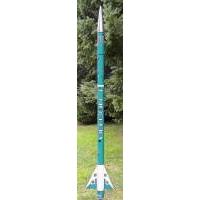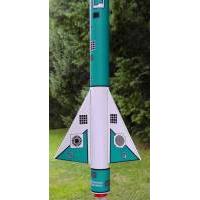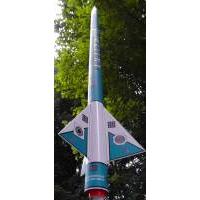| Construction Rating: | starstarstarstarstar |
| Flight Rating: | starstarstarstarstar |
| Overall Rating: | starstarstarstarstar |
| Published: | 2013-06-26 |
| Manufacturer: | Quasar One  |
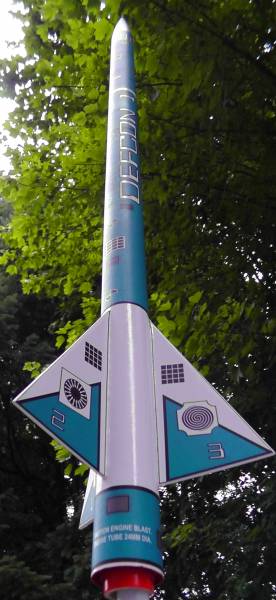 Brief
Brief
The DEFCON 1 is a 24mm, mid-size rocket kit from the late Quasar One company. The design is a good performer, the styling is beautiful and easy to achieve with the decals, and the short fins will resist damage on a hard landing. It is powered with C,D,E and possibly F engines (although using an F makes this a one-time-use rocket, you'll likely never see it again as it reaches almost 1/2 mile!) In summary, it is a very good quality kit and a good flier. Standing almost 40 inches high, it is an impressive, sleek looking model.
The "story" behind the DEFCON 1 is that this is a rocket carrying radiation detection equipment, to have been used in the cold war to detect radiation at high altitudes to confirm the detonation of enemy nuclear bombs. The US was to send a bunch of these up for confirmation before pressing the "button". I don't know if these types of rockets exist in the real world, but the story seems plausable.
Since this model looks so good and flies well, it is one of my most favorite models in my fleet.
Components
The rocket is constructed from one very long tube with no couplers. Component quality was extremely good throughout, with the possible exception of the nosecone. The motor tube has a inner foil layer, reported to resist the heat of the motors. The centering rings were heavy duty. The fin stock was very good, stiff and dense. The 34-inch shock cord elastic was plenty long and sturdy and included a Kevlar segment. The parachute was aqua, matching the color of the decals, and made of thicker plastic, slightly textured. Even the shroud lines were longer, allowing me to make shrouds 1-1/2 times the diameter of the parachute - in my opinion the longer shrouds work better. A swivel for the parachute was also included in the kit.
Unfortunately the body tube was so long that it was bent in shipping. Apogee Components did not pack it well. A replacement was sent - also bent. I sent specific instructions to Apogee concerning the packing of the last remaining replacement tube, but they ignored it and I received a tube packed so that it was pretty much a guarantee it would be bent also: Each long end of the tube was reinforced, leaving a few inches of the middle of the tube open to absorb all the stresses from shipping. The very densly packed paper filling left no room for give and transmitted the handling forces directly to the tube middle. Apogee then apologized that they had no more tubes to send. Tim V. wrote back essentially saying "too bad, it happens, there is no practical solution". (A very taboo statement from an engineer!) If Timmy would have ever ordered a large print from Shutterfly he would see how it can be done! But I digress.
I managed to assemble the rocket from the undamaged parts of both tubes, and since I intended to add a payload section to this very long rocket, I cut the tubes to be the main body and payload section. As for the quality of the tube from Quasar One, it was as good as any body tube I've used. I couldn't alter the overall length of the body tube though, or the full-wrap decals would not have fit. The huge, full-wrap water-slide decals were also tough enough to not rip. The spiral seams in the tubing were almost unnoticeable after primer, paint and then the decals. Almost unnoticeable - if you look real hard, you can find some traces of spirals, but not enough to bother me at all.
Construction
Construction was routine with no big issues, but a few small ones needed to be dealt with. You already read about the damaged tubes, but by adding a bulkhead and payload section I could connect the two shorter-cut sections of tubes without needing a coupler. The well-written instructions warn you not to sand too much off the fins when rounding them, otherwise the decals for the fins will be too big to fit. The only quality issue I had to deal with is the plastic nose cone was molded with a noticeable depression in the one side. A little plastic filler and some sanding fixed that right up. Another item to be sure about is the placement of the launch lugs. If you do not place them where indicated, the decals will not cleanly fit over them. This model design uses a split lug, a small detail I build into every rocket because it is much more stable when launching.

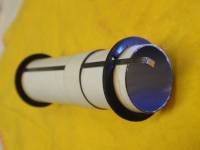

Finishing
Considering the complex look of this rocket, finishing was very easy! Just a good prime and paint with gloss white is all that is needed, except the nose cone which is painted silver. The full-wrap decals handle all the design work of the body tube, and decals cover the entire fin area on both sides. Because of that filling/sealing the balsa grain is not really necessary. The body wrap decals were a bit oversized though, so that they overlap about 3/16 inch. The overlap area looks quite a bit darker then the rest of the decal color, so there is a small darker strip down the length of the "back" of the rocket tube. That is the only thing detracting from the looks of this rocket. Next time I will verify the width of a body-wrap decal, cutting a bit off the width would have solved this.
It may be a bit difficult to place those large decals on the body, but I just took my time, kept them wet and positioned them in place and nothing was torn while padding out the wrinkles with a paper towel. When completed it looked awesome, but the semi-gloss of the decals seemed to disappear once applied. A few coats of clearcoating brought the gloss back, and this is probably the best looking rocket in my fleet. Warning though: the decals are not opaque, and a few minor slips of the paintbrush (I painted the nozzle area red) show right through the color. I was hoping the decal would cover the brush slips, but they did not.
Another caution to observe: The decal sheet had tiny numbers (part numbers or whatever) that are not to be used on the rocket. Cut these off before dunking in water. I didn't, and the tiny numbers floated off into the water (they had no clear backing) and some of them ended up on the rocket as tiny specks of 'dirt'. It took quite a while to pick them off one-by-one.

I would like to give this model kit Four-and-a-half out of five stars. Although the decals can be challenging, it is certianly worth the effort because the finished product is excellent. High marks go out to Quazar One for telling the truth in the specs. Even when finished completely, my rocket was a few grams less than stated, even with an added balsa bulkhead and an ejection baffle.
Flight
This rocket flies very well, even in somewhat stronger winds. Using the smallest C11 motors, it accelerated at about 5 Gs, enough to fly straight up and reach 60-80 mph. A 5 second delay was about perfect for this model. On the C, it will only reach about 200-300 feet. The same should be true of an 18mm C6 motor, perhaps a bit more speed and altitude, but I haven't tried them yet.
Using a D12-5, I could reach 600-800 feet at 120-140 mph. A D12-7 should have a more ideal delay. I haven't had the guts to try an E yet though, it is reported to reach about 2000 feet. An F could likely get you one-half of a mile up.
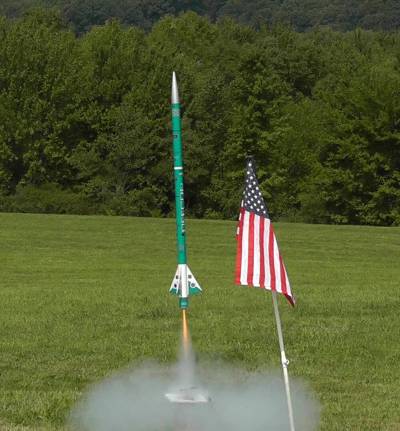
I would have to give this rocket a 5 out of 5. It is big enough to stay low when you are in small fields or flying in windy conditions, but has the legs to fly much higher with a D motor, or reach extreme altitudes with an E or F motor. You should be able to fly this rocket in almost any reasonable conditions.
Recovery
The parachute appears to be the right size for this model, letting it descend at 8-10 mph. You might want something smaller with the larger motors though, the rocket seems to be able to take a rough landing (I landed a few with stuck 'chutes and no damage). The additional shroud length helps the parachute open well and make a nice canopy, and the included swivel link is certianly recommended. The texture of the plastic material seems to help prevent it from being "sticky".
Summary
I feel this was the best quality kit I have ever assembled, compared to Quest and Estes. New Way and Red River Rocketry are very good, but this kit wins in quality by a small margin. Too bad they didn't seem to catch on in sales though, I would have welcomed the chance to buy another Quazar One kit.
A full five stars for this kit, the design of the rocket and the styling. I've never built any rocket kit so easily and had it come out looking and flying so well. (No, I didn't get paid by Quasar One!)
 |
 |
Flights
Sponsored Ads
 |
 |


